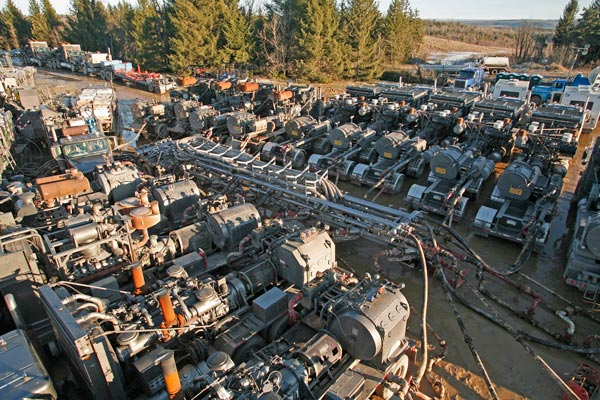Now that the rig market for oil and gas projects is heating up again, it's time to invest where energy's big-money cycle actually begins.
After all, without a rig, a well is nothing more than a dot on a map.
That's why the oil field service (OFS) business always improves before the fortunes of field production companies.
But there's an even earlier link in this profit chain...
It's a smaller industry, and may not get much coverage. But the OFS business wouldn't exist without it... and neither would the all of those oil wells.
That's why the company we'll look at today is one of my favorite oil and gas plays.
First, take a look at these pumping trucks...
Producers Pay Big Money for Equipment Like This
You can make a fortune investing in companies that manufacture and distribute all the massive equipment each well requires.
Pressure pumps, drill bits, down-hole motors...
Take a look at these pumping trucks, for example:

These are just some of the special trucks needed for a frack job. In this case, we're looking at a medium-sized well site in the Marcellus, just over the line in northern West Virginia, where I was evaluating the footprint of the drilling pad.
Fracking work at unconventional sites requires water pushed downhole under heavy pressure.
That, in turn, requires a large array of pumping trucks and ancillary equipment surrounding the well head, along with compressor stations (to maintain pipeline pressure levels), retention basins (for flowback water) and a range of site specific processing and separation units.
The picture above shows just a portion of what the pumping footprint at a small frack operation looks like.
Make no mistake: A working well is a massive display of parts and machinery. And selling this equipment is good money.
So is servicing it.
That's why some of the biggest OFS providers - like Schlumberger (NYSE: SLB), Halliburton (NYSE: HAL) and Weatherford International (NYSE: WFT) - have been buying up oil and gas equipment makers.
It's part of an ongoing move by the big OFS outfits to consolidate access and increase profitability.
But the market for equipment in general and rigs in particular is a very fluid one.
There is also another factor to consider: When there's an upsurge in equipment demand like the one developing right now, there is also an inflationary factor.
Put simply, as the demand heats up, so does the pricing spiral. But that's good news for the individual investor in the equipment sector.
In this case, the returns on the equipment slice of the business are registered up front, while the downward drag takes place further down the chain.
It is also important to remember that the oil-and-gas equipment market is global. While rig demand is growing in North America, the need to develop fields is even more pressing in other parts of the world.
That's adding even more overall demand to a business with already limited availability. And unconventional production (shale and tight gas, tight oil) has only made this situation worse.
Since the pay zones in these fields are horizontal rather than vertical, drilling equipment is more expensive and subject to more frequent delays in availability.
"Expensive," of course, is a good thing if your company is doing the selling.
So let's look at all this money from the investor's perspective...
Two OFS "Catch-Alls"... and My Favorite Company
With all the M&A going on in the OFS sector, and its reach further "upstream" into the manufacturing and distribution segment, being able to comb through all of these opportunities could be a full-time job.
But it doesn't have to be with the two suggestions I'm about to give you.
The first is to use exchange-traded funds (ETFs) that focus on the equipment and its utilization. The second identifies a company likely to be in the center of this move.
First up are the ETFs...
I have periodically recommended to Energy Advantageand Energy Inner Circlemembers two standouts in this sector - the SPDR S&P Oil & Gas Equipment and Services ETF (NYSEArca: XES) and the Market Vectors Oil Service Holders ETF (NYSE MKT: OIH).
Both of these funds encompass the equipment and OFS sides of the business, although XES may be the more focused play if you're looking to primarily target the equipment prospects. But XES has been performing better than OIH of late, making it the better move.
It is important to keep in mind that ETFs also charge fees. While those fees are merely deducted from the share level realized, they nonetheless also reduce your returns.
But there is one company that stands to benefit most directly from what is happening in the equipment sector.
It's National Oilwell Varco (NYSE: NOV).
This is one of the primary stand-alone (i.e., has not been acquired by an OFS big boy) providers of oilfield equipment and service.
If you're a member of Energy Advantage, you'll see more and more coverage on this one going forward. But check it out either way. And definitely consider picking up shares now, before the next significant run gets underway.
About the Author
Dr. Kent Moors is an internationally recognized expert in oil and natural gas policy, risk assessment, and emerging market economic development. He serves as an advisor to many U.S. governors and foreign governments. Kent details his latest global travels in his free Oil & Energy Investor e-letter. He makes specific investment recommendations in his newsletter, the Energy Advantage. For more active investors, he issues shorter-term trades in his Energy Inner Circle.



